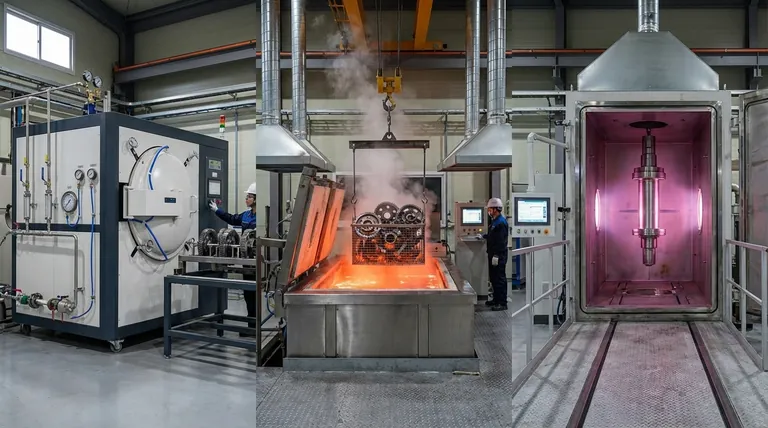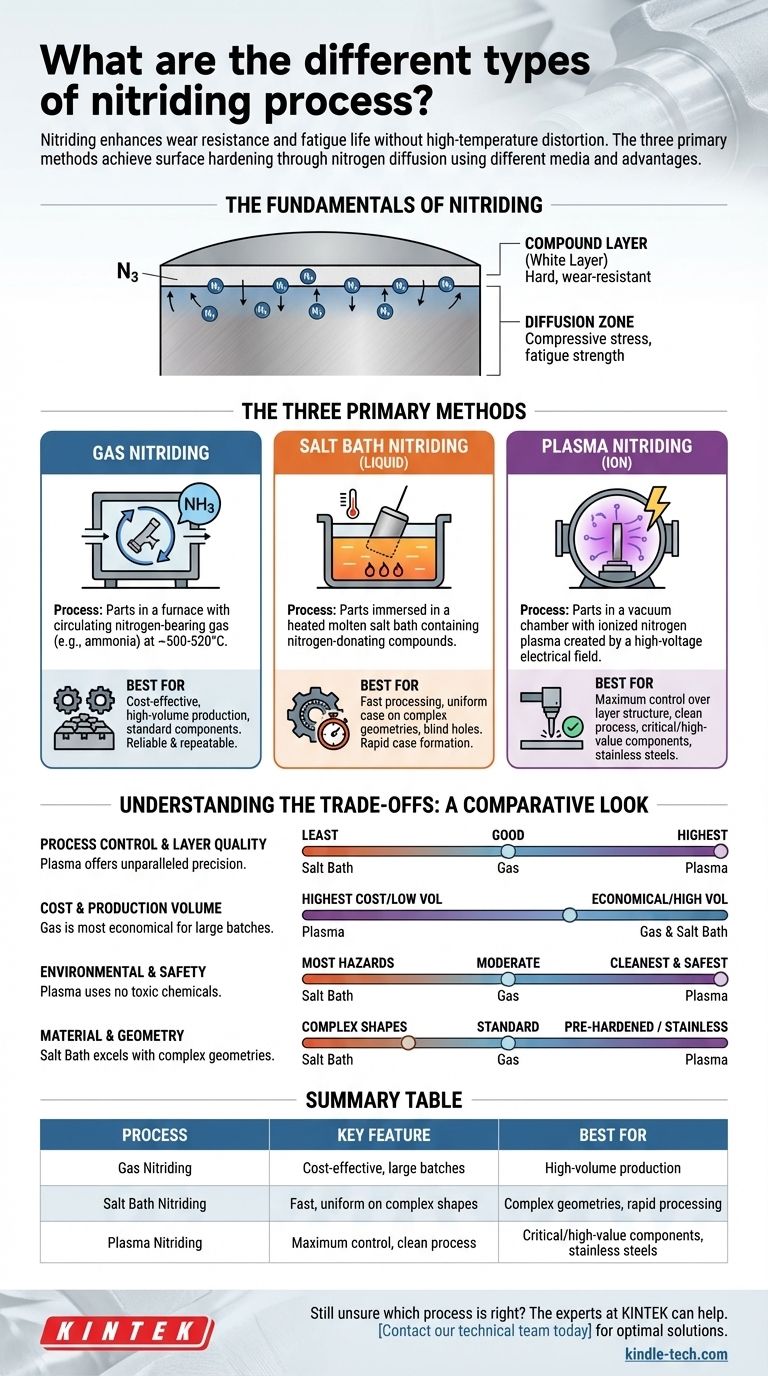在选择表面硬化方法时,渗氮因其在不需引起变形的高温下提高耐磨性和疲劳寿命的能力而脱颖而出。渗氮的主要类型有气体渗氮、盐浴(液体)渗氮和等离子(离子)渗氮。虽然这三种工艺都通过将氮扩散到钢或合金零件中来实现表面硬化,但它们使用根本不同的介质,并在控制、成本和应用方面提供独特的优势。
气体渗氮、盐浴渗氮和等离子渗氮之间的选择,并非哪种“最好”,而是哪种工艺能为您的特定工程要求提供冶金控制、生产量和成本的最佳平衡。
渗氮的基础知识
要选择一种工艺,您必须首先了解目标。渗氮并非一成不变;它会形成具有不同区域的结构化表面。
什么是渗氮?
渗氮是一种热化学表面硬化工艺,它将氮原子扩散到金属表面。这会与基体金属及其合金元素形成硬质氮化物化合物,从而显著提高表面硬度。
目标:化合物层和扩散区
该过程形成两个主要层。最外层的化合物层(或“白层”)极其坚硬,提供卓越的耐磨性和耐腐蚀性。
在其下方,扩散区是氮原子渗透到材料晶格中,产生压应力的地方。该区域负责显著提高疲劳强度。

三种主要的渗氮方法
每种方法都使用不同的介质将氮输送到组件表面,这直接影响工艺特性。
气体渗氮
这是最传统和广泛使用的方法。零件被放置在炉中,炉内循环着含氮气体,最常见的是氨气(NH3)。
在500-520°C的典型温度下,氨气在钢表面分解,释放出活性氮原子,这些原子扩散到零件中。
气体渗氮的主要优点是其处理大量组件的成本效益。这是一种成熟且高度可重复的工艺。
盐浴渗氮(液体渗氮)
此方法涉及将零件浸入含有供氮化合物的加热熔融盐浴中。这些通常是基于氰化物-氰酸盐的盐。
该工艺常被称为Tenifer或Melonite等商品名。它比气体渗氮更快,并且非常适合在复杂形状上生产均匀的表层。
许多盐浴工艺实际上是氮碳共渗,因为它们将氮和少量碳引入表面以增强性能。
等离子渗氮(离子渗氮)
等离子渗氮是技术最先进的方法。零件被放置在真空室中,然后回填精确混合的气体,主要是氮气。
施加高压电场,在组件周围产生电离气体或等离子体。这些氮离子被加速并轰击零件表面,使其加热并提供用于扩散的活性氮。
此方法对渗氮层的结构和成分提供了无与伦比的控制。
了解权衡:比较分析
没有一种工艺在所有情况下都是最优的。正确的选择取决于平衡性能需求与实际限制。
工艺控制和层质量
等离子渗氮提供最高程度的控制。通过精确管理气体混合物、压力和电气参数,您可以选择性地控制化合物层的生长。这对于不希望出现脆性白层的应用至关重要。
气体渗氮对渗层深度有很好的控制,但与等离子渗氮相比,对化合物层的相组成控制较少。盐浴渗氮的工艺控制最少。
成本和生产量
气体渗氮对于大批量生产来说是最经济的。设备和耗材相对便宜,大型炉可以一次处理许多零件。
盐浴渗氮也适用于大批量工作。等离子渗氮的初始设备成本最高,通常更适合小批量或单个高价值组件。
环境和安全影响
等离子渗氮是最清洁、最安全的工艺。它不使用有毒化学品,也不产生有害副产品。
气体渗氮使用大量氨气,这是一种有毒易燃气体,需要小心处理。盐浴渗氮由于使用高温、有毒的氰化物盐以及由此产生的处置挑战,带来了最重大的危害。
材料和几何形状考量
等离子渗氮的较低处理温度使其非常适合预硬化钢,因为它可以在材料回火温度以下进行渗氮,从而保持核心强度。它对不锈钢也特别有效。
盐浴渗氮擅长处理具有非常复杂几何形状、盲孔和小孔的零件,因为液体确保了完全均匀的表面接触。
为您的应用选择正确的工艺
您的最终决定应由项目最关键的因素来指导。
- 如果您的主要关注点是经济高效地处理大批量产品:气体渗氮是行业标准,并提供可靠的性能平衡。
- 如果您的主要关注点是关键部件的最大控制和性能:等离子渗氮对表层结构提供无与伦比的精度,使其成为高价值应用的理想选择。
- 如果您的主要关注点是速度和处理复杂几何形状的零件:盐浴渗氮提供快速的表层形成,但需要仔细管理危险材料。
通过了解这些核心差异,您可以选择与您的工程目标和操作能力完美契合的渗氮工艺。
总结表:
| 工艺 | 主要特点 | 最适合 |
|---|---|---|
| 气体渗氮 | 成本效益高,大批量 | 大批量生产,标准部件 |
| 盐浴渗氮 | 快速,复杂形状上均匀 | 复杂几何形状,快速处理 |
| 等离子渗氮 | 最大控制,清洁工艺 | 关键/高价值部件,不锈钢 |
仍然不确定哪种渗氮工艺适合您的部件? KINTEK 的专家随时为您提供帮助。我们专注于为材料测试和分析(包括表面硬化工艺)提供实验室设备和耗材。我们可以帮助您分析材料、几何形状和性能的特定要求,以推荐最佳解决方案。立即联系我们的技术团队 讨论您的项目,并确保您为您的应用获得完美的表面性能。
图解指南




















